- Captured On
- Source
- Operations on Fourier Series | Unit III: Fourier Series and Laplace Transform | Differential Equations | Mathematics | MIT OpenCourseWare
1 What is an even function?
1.1 Front
What is an even function?
Let \(f(t)\) be a function, and write examples
1.2 Back
\(f(t)\) is even if \(f(-t) = f(t)\) for all \(t\)
- \(t^2, t^4, t^6, \dots\), any
evenpower of \(t\) - \(\cos(at)\)
- power series for \(\cos(at)\) has only
evenpowers of \(t\)
- power series for \(\cos(at)\) has only
- A constant function
2 What is the integral of even function on a ‘balanced’ interval?
2.1 Front
What is the integral of even function on a ‘balanced’ interval?
Let \(f(t)\) an even function, and \([-L, L]\) the interval
\({\displaystyle \int_{-L}^L f(t) \dd{t}}\)
2.2 Back
\({\displaystyle 2 \int_0^L f(t) \dd{t}}\)
3 This function is even or odd?
3.1 Front
This function is even or odd?
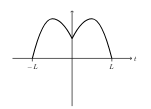
3.2 Back
Even function
4 What is an odd function?
4.1 Front
What is an odd function?
Let \(f(t)\) be a function, and write examples
4.2 Back
\(f(t)\) is odd if \(f(-t) = -f(t)\) for all \(t\)
- \(t, t^3, t^5, \dots\) any
oddpowers of \(t\) - \(\sin(at)\)
- Power series of \(\sin(at)\) has only
oddpowers of \(t\)
- Power series of \(\sin(at)\) has only
5 What is the integral of odd function on a ‘balanced’ interval?
5.1 Front
What is the integral of odd function on a ‘balanced’ interval?
Let \(f(t)\) be an odd function, and \([-L, L]\) the interval
\({\displaystyle \int_{-L}^L f(t) \dd{t}}\)
5.2 Back
\(0\)
6 How is the outcome function after multiplicate these functions?
6.1 Front
How is the outcome function after multiplicate these functions?
\(\text{even} \cross \text{even}\)
6.2 Back
\(\text{even} \cross \text{even} = \text{even}\)
Thinks in terms of multiply even or odd powers of \(t\)
7 How is the outcome function after multiplicate these functions?
7.1 Front
How is the outcome function after multiplicate these functions?
\(\text{odd} \cross \text{odd}\)
7.2 Back
\(\text{odd} \cross \text{odd} = \text{even}\)
Thinks in terms of multiply even or odd powers of \(t\)
8 How is the outcome function after multiplicate these functions?
8.1 Front
How is the outcome function after multiplicate these functions?
\(\text{odd} \cross \text{even}\)
8.2 Back
\(\text{odd} \cross \text{even} = \text{odd}\)
Thinks in terms of multiply even or odd powers of \(t\)
9 How are the Fourier coefficients when \(f(t)\) is even?
9.1 Front
How are the Fourier coefficients when $f(t)$ is even?
Let \(f(t)\) be an even function
9.2 Back
\(b_n = 0\), multiplying and even and odd function, the integrand is odd, so the integral is \(0\)
\({\displaystyle a_n = \frac{2}{L} \int_0^L f(t) \cos(n \frac{\pi}{L} t) \dd{t}}\)
Multiplying 2 even functions, the integrand is even.
10 How are the Fourier coefficients when \(f(t)\) is odd?
10.1 Front
How are the Fourier coefficients when $f(t)$ is odd?
Let \(f(t)\) be an odd function
10.2 Back
\(a_n = 0\), because of the integrand is odd, so the integral is \(0\)
\({\displaystyle b_n = \frac{2}{L} \int_0^L f(t) \sin(n \frac{\pi}{L} t) \dd{t}}\)
The integrand is even after multiply 2 odd functions
11 Shift vertically this odd function by 1 upwards unit?
11.1 Front
Shift vertically this odd function by 1 upwards unit?
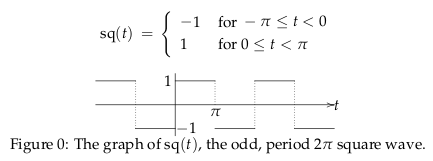
Where \({\displaystyle sq(t) = \frac{4}{\pi} \sum_{n \text{odd}}^{\infty} \frac{\sin(nt)}{n}}\)
11.2 Back

\({\displaystyle f_1 (t) = 1 + sq(t) = 1 + \frac{4}{\pi} \sum_{n \text{odd}}^{\infty} \frac{\sin(nt)}{n}}\)
12 Scale vertically this odd function by 2 upwards units?
12.1 Front
Scale vertically this odd function by 2 upwards units?
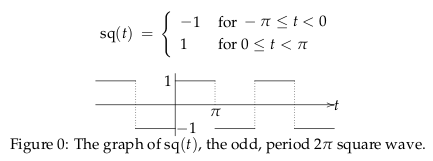
Where \({\displaystyle sq(t) = \frac{4}{\pi} \sum_{n \text{odd}}^{\infty} \frac{\sin(nt)}{n}}\)
12.2 Back
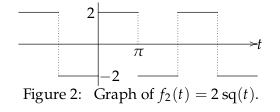
\({\displaystyle f_2(t) = 2 sq(t) = \frac{8}{\pi} \sum_{n \text{odd}}^{\infty} \frac{\sin(nt)}{n}}\)
13 Shift by \(1\) and scale by \(1/2\) vertically this function
13.1 Front
Shift by $1$ and scale by $1/2$ vertically this function
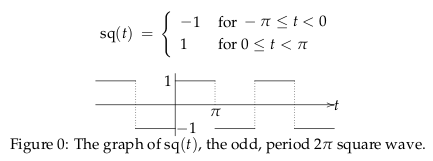
Where \({\displaystyle sq(t) = \frac{4}{\pi} \sum_{n \text{odd}}^{\infty} \frac{\sin(nt)}{n}}\)
13.2 Back

\({\displaystyle f_3(t) = \frac{1}{2} \biggl(1 + sq(t) \biggr) = \frac{1}{2} + \frac{2}{\pi} \sum_{n \text{odd}}^{\infty} \frac{\sin(nt)}{n}}\)
14 Scale in time this function
14.1 Front
Scale in time this function
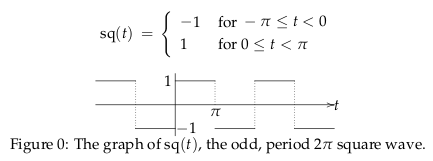
Where \({\displaystyle sq(t) = \frac{4}{\pi} \sum_{n \text{odd}}^{\infty} \frac{\sin(nt)}{n}}\)
In the new function \(\pi \to 1\) in time axis
14.2 Back
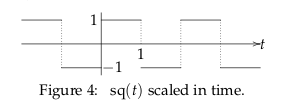
\({\displaystyle f_4 (t) = sq(\pi t) = \frac{4}{\pi} \sum_{n \text{odd}}^{\infty} \frac{\sin(\pi n t)}{n}}\)
15 Shift in time by \(\pi/2\) to the left this function
15.1 Front
Shift in time by $\pi/2$ to the left this function
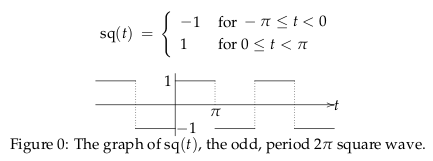
Where \({\displaystyle sq(t) = \frac{4}{\pi} \sum_{n \text{odd}}^{\infty} \frac{\sin(nt)}{n}}\)
15.2 Back
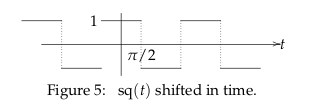
\({\displaystyle f_5(t) = sq(t + \pi/2) = \frac{4}{\pi} \biggl(\sin(t + \pi/2) + \frac{\sin(3t + 3\pi/2)}{3} + \cdots \biggr) = \frac{4}{\pi} \biggl(\cos(t) - \frac{\cos(3t)}{3} + \cdots \biggr)}\)
\(f_5(t)\) is an even function, so you must have only cosine terms in its series
16 How can you integrate a Fourier series
16.1 Front
How can you integrate a Fourier series
Let \(f(t)\) be a Fourier series
Will it be a periodic function?
16.2 Back
Term by terms, but the outcome isn’t a Fourier series (it’s not periodic), because of the \(t\) term
17 How can you differentiate a Fourier Series?
17.1 Front
How can you differentiate a Fourier Series?
Let \(f(t)\) be a Fourier series
17.2 Back
Term by term
18 What is the result of derivative a triangle wave function?
18.1 Front
What is the result of derivative a triangle wave function?
Let \(f(t)\) be the period of \(2\pi\) triangle wave (continuous sawtooth) given on the interval \([-\pi, \pi]\) by \(f(t) = \abs{t}\)
\({\displaystyle f(t) = \frac{\pi}{2} - \frac{4}{\pi} \biggl(\cos(t) + \frac{\cos(3t)}{3^2} + \frac{\cos(5t)}{5^2} + \cdots \biggr)}\)
18.2 Back
The derivative terms by terms of this function, give us a square wave.
\({\displaystyle f’(t) = \frac{4}{\pi} \biggl(\sin(t) + \frac{\sin(3t)}{3} + \frac{\sin(5t)}{5} + \cdots \biggr)}\)
19 What does mean to differentiate a square wave functions?
19.1 Front
What does mean to differentiate a square wave functions?
\({\displaystyle sq(t) = \frac{4}{\pi} \biggl(\sin(t) + \frac{\sin(3t)}{3} + \frac{\sin(5t)}{5} + \cdots \biggr)}\)
19.2 Back
You can differentiate this function term-by-terms, but as \(sq(t)\) consists of horizontal segments its derivative at most places is 0. However we can’t ignore the ‘vertical’ segments where the function has jump discontinuity
You need delta functions and generalized derivatives
20 What is a piecewise smooth function?
20.1 Front
What is a piecewise smooth function?
Let \(f(t)\) be a \(2L\) periodic function
20.2 Back
\(f(t)\) is called piecewise smooth
- if there are a only finite number of points \(0 \leq t_1 \lt t_2 \lt \dots \lt t_n \leq 2L\) where \(f(t)\) is not differentiable, and
- if at each of these points the left and ther righ-hand limits \({\displaystyle \lim_{t \to t_i^-} f’(t)}\) and \({\displaystyle \lim_{t \to t_i^+} f’(t)}\) exist (although they might not be equal)
Example:
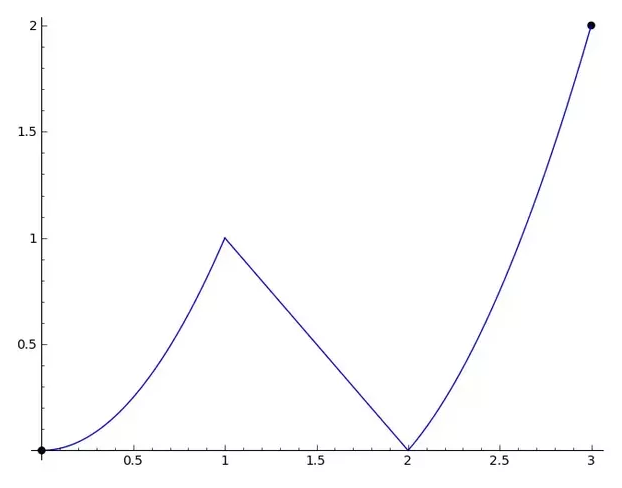
21 Are the functions and its Fourier series exactly the same function?
21.1 Front
Are the functions and its Fourier series exactly the same function?
Put examples
21.2 Back
Not, it’s not, it really quite similar but isn’t the same


22 How converges a Fouries series of \(f(t)\)
22.1 Front
How converges a Fouries series of $f(t)$
Let \(f(t)\) be the a function
22.2 Back
\(f(t)\) must be a periodic piecewise smooth function, then its Fourier series:
- converges to \(f(t)\) at values of \(t\) where \(f\) is continuous
- converges to the average of \(f(t^-)\) and \(f(t^+)\) where it has a jump discontinuity


23 What is the Fourier Analysis?
23.1 Front
What is the Fourier Analysis?
23.2 Back
It’s the decomposition of a function \(f(t)\) into the sum of its sinusoidal harmonics, which are also called its Fourier components
For example, the ear is a fourier analyzer
24 What is the Fourier Synthesis?
24.1 Front
What is the Fourier Synthesis?
24.2 Back
It’s the building up of a function \(f(t)\) by adding up its successive Fourier components, that is, the reconstruction of a function \(f(t)\) from its Fourier components.
For example, the brain is a Fourier synthesizer
25 Why there is an overshoot near the discontinity on a Fourier series?
25.1 Front
Why there is an overshoot near the discontinity on a Fourier series?
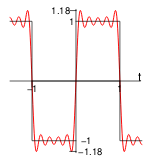
In this picture, the overshoot is about \(0.18\)
25.2 Back
It’s called Gibbs’ phenomenon, and doesn’t matter how many terms are include in the Fourier series. The overshoot always be about \(9%\) of the size of the jump.
In this case, the overshoot is \(0.18\) that it’s the \(9%\) of the jump of \(2\)
26 Given this Fourier Series, what is the value of this formula?
26.1 Front
Given this Fourier Series, what is the value of this formula?
Let \({\displaystyle f(t) = \frac{\pi^2}{3} - 2 \sum_{n=1}^{\infty} \frac{\cos(nt)}{n^2}}\) be the Fouries series of \({\displaystyle f(t) = t \biggl(\pi - \frac{t}{2}\biggr)}\) on \([0, 2\pi]\)
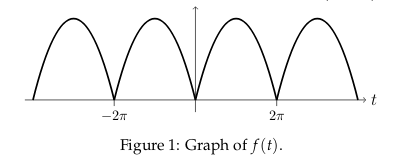
Formula: \({\displaystyle \sum_{n=1}^{\infty} \frac{1}{n^2}}\)
26.2 Back
Since the function \(f(t)\) is continuous, the series converges to \(f(t)\) for all \(t\). Pluggin in \(t = 0\), we get
\({\displaystyle f(0) = 0 = \frac{\pi^2}{3} - \sum_{n=1}^{\infty} \frac{2}{n^2}}\)
so, \({\displaystyle \sum_{n=1}^{\infty} \frac{1}{n^2} = \frac{\pi^2}{6}}\)
27 What is the Fourier series for this function?
27.1 Front
What is the Fourier series for this function?
\({\displaystyle f(t) = \cos(2t - \frac{\pi}{4})}\)
27.2 Back
This function is a trigonmetric function, which could be decomposing using the trigonometric identity \(\cos(A - B) = \cos(A) \cos(B) + \sin(A) \sin(B)\)
\({\displaystyle f(t) = \cos(2t) \cos(\frac{\pi}{4}) + \sin(2t) \sin(\frac{\pi}{4}) = \frac{1}{\sqrt{2}} \biggl(\cos(2t) + \sin(2t) \biggr)}\)
28 Given this Fourier series compute \(f(t)\) Fourier series?
28.1 Front
Given this Fourier series compute $f(t)$ Fourier series?
\({\displaystyle sq(t) = \begin{cases} -1 & -\pi \lt t \lt 0 \ 1 & 0 \lt t \lt \pi \end{cases} = \frac{4}{\pi} \sum_{n \text{odd}}^{\infty} \frac{\sin(nt)}{n}}\)
\({\displaystyle f(t) = \abs{t}}\) on \(-\pi \lt t \lt \pi\) with period \(2\pi\)
28.2 Back
We can see that \(f’(t) = sq(t)\) on the interval, so \(f(t) = \int sq(t) \dd{t}\)
\({\displaystyle f(t) = \int \frac{4}{\pi} \sum_{n \text{odd}}^{\infty} \frac{\sin(nt)}{n} \dd{t} = C + \frac{4}{\pi} \sum_{n \text{odd}}^{\infty} - \frac{\cos(nt)}{n^2}}\)
The constant \(C\) could be get using Fourier coefficients
\({\displaystyle C = \frac{1}{2\pi} \int_{-\pi}^{\pi} \abs{t} \dd{t} = \frac{1}{\pi} \int_0^{\pi} t \dd{t} = \frac{1}{\pi} \frac{\pi^2}{2} = \frac{\pi}{2}}\)
29 How could we get a Fourier series from square wave Fouries series?
29.1 Front
How could we get a Fourier series from square wave Fouries series?
Square wave: \(sq(t) = 1\) for \(0 \lt t \lt \pi\), it’s a \(2\pi\) period odd function, which Fourier series is \({\displaystyle \frac{4}{\pi} \sum_{n \text{ odd}}^{\infty} \frac{\sin(nt)}{n}}\)
Find Fourier Series for \(h(t)\) which is a odd and periodic of period \(2\pi\) and such that \(h(t) = t\) for \({\displaystyle 0 \lt t \lt \frac{\pi}{2}}\) and \(h(t) = \pi - t\) for \({\displaystyle \frac{\pi}{2} \lt t \lt \pi}\)
29.2 Back
We can see that \(sq(t)\) could be the derivative of \(h(t)\) but first we need to resize it on time axis from \(\pi\) to \(\pi / 2\)
\begin{align*} h’(x) &= sq(t + \pi/2) \\\ &= \frac{4}{\pi} \sum_{n \text{ odd}}^{\infty} \frac{\sin(n (t + \pi / 2))}{n} \\\ &= 1 + \frac{4}{\pi} \cos(t) - \frac{4}{3 \pi} \cos(3t) + \frac{4}{5\pi} \cos(5t) + \cdots \end{align*}
So, the Fourier Series of \(h(t)\) is
\begin{align*} h(x) &= \int sq(t + \pi / 2) \dd{t} \\\ &= \int 1 + \frac{4}{\pi} \cos(t) - \frac{4}{3 \pi} \cos(3t) + \frac{4}{5\pi} \cos(5t) + \cdots \dd{t} \\\ &= \frac{4}{\pi} \sin(t) - \frac{4}{9\pi} \sin(3t) + \frac{4}{25\pi} \sin(5t) + \cdots \end{align*}
\(h(t)\) doesn’t have constant because it’s a odd function
30 What is the Fourier Series for this function?
30.1 Front
What is the Fourier Series for this function?
\(\sin^2(t)\)
30.2 Back
Using trigonometric identity of double angle formula \(\cos(2t) = 1 - 2 \sin^2(t)\)
\({\displaystyle \sin^2(t) = \frac{1}{2} - \frac{1}{2} \cos(2t)}\)
- As \(\sin^2(t)\) it’s an even function, there is no \(b_n\) coefficients
- This function has a base period of \(\pi\)
31 Why any function \(F(x)\) is a sum of an even function an an odd function?
31.1 Front
Why any function $F(x)$ is a sum of an even function an an odd function?
So, that the decomposition is unique
31.2 Back
- Even function from \(F(x)\): \(F(x) + F(-x)\)
- \(h(x) = f(x) + f(-x)\)
- \(h(-x) = f(-x) + f(x)\)
- \(h(x) = h(-x)\), that is an even function
- Odd function from \(F(x)\): \(F(x) - F(-x)\)
- \(h(x) = f(x) - f(-x)\)
- \(h(-x) = f(-x) - f(-x)\)
- \(-h(x) = h(-x)\), that is an odd function
Adding both functions: \(F(x) + F(-x) + F(x) - F(-x) = 2 F(x)\), so
\({\displaystyle F(x) = \frac{F(x) + F(-x)}{2} + \frac{F(x) - F(-x)}{2}}\)
To show that this decomposition is unique, we suppose we have another decomposition \({\displaystyle F_{\text{even}}(x) + F_{\text{odd}}(x) = F(x) = \frac{F(x) + F(-x)}{2} + \frac{F(x) - F(-x)}{2}}\)
Rearranging terms, this means that
\({\displaystyle f_{\text{even}}(t) - \frac{F(x) + F(-x)}{2} = -F_{\text{odd}}(x) + \frac{F(x) - F(-x)}{2}}\)
This sum of the LHS must be even, and the sum of the RHS must be odd. But then each side is simultaneously both even and odd, and has to be zero.
Thus: \({\displaystyle F_{\text{even}} = \frac{F(x) + F(-x)}{2}}\) and \({\displaystyle F_{\text{odd}} = \frac{F(x) - F(-x)}{2}}\)
32 What is the even part of \(e^{x}?\)
32.1 Front
What is the even part of $e^{x}$?
32.2 Back
\({\displaystyle \frac{e^x + e^{-x}}{2} = \cosh x}\)
33 What is the odd part of \(e^{x}\)?
33.1 Front
What is the odd part of $e^{x}$?
33.2 Back
\({\displaystyle \frac{e^x - e^{-x}}{2} = \sinh x}\)
34 Compute the Fourier Series for this function?
34.1 Front
Compute the Fourier Series for this function?
\(2 \sin(t - \frac{\pi}{3})\)
34.2 Back
\({\displaystyle 2 \sin(t - \frac{\pi}{3}) = 2 \biggl( \cos(\frac{\pi}{3})\sin(t) - \sin(\frac{\pi}{3}) \cos(t) \biggr) = \sin(t) - \sqrt{3} \cos(t)}\)
35 Is this relationship equals?
35.1 Front
Is this relationship equals?
\(\sin(2\pi t) = \sin(t)\)
35.2 Back
Not, it isn’t the same